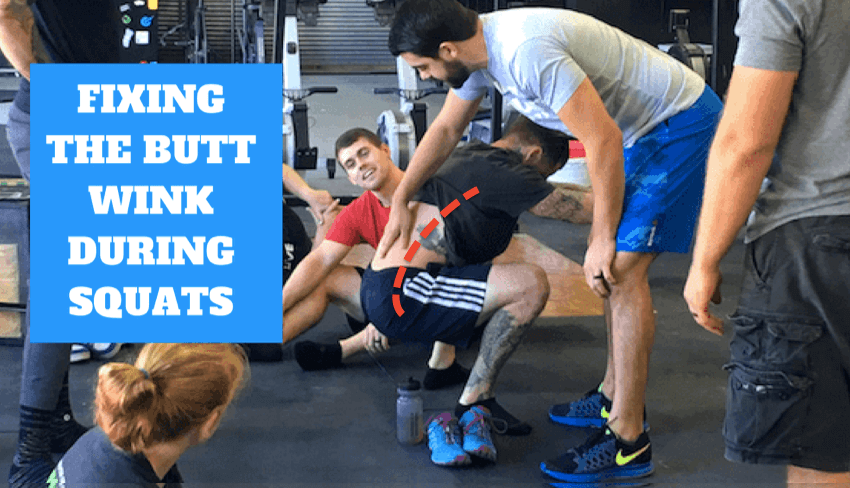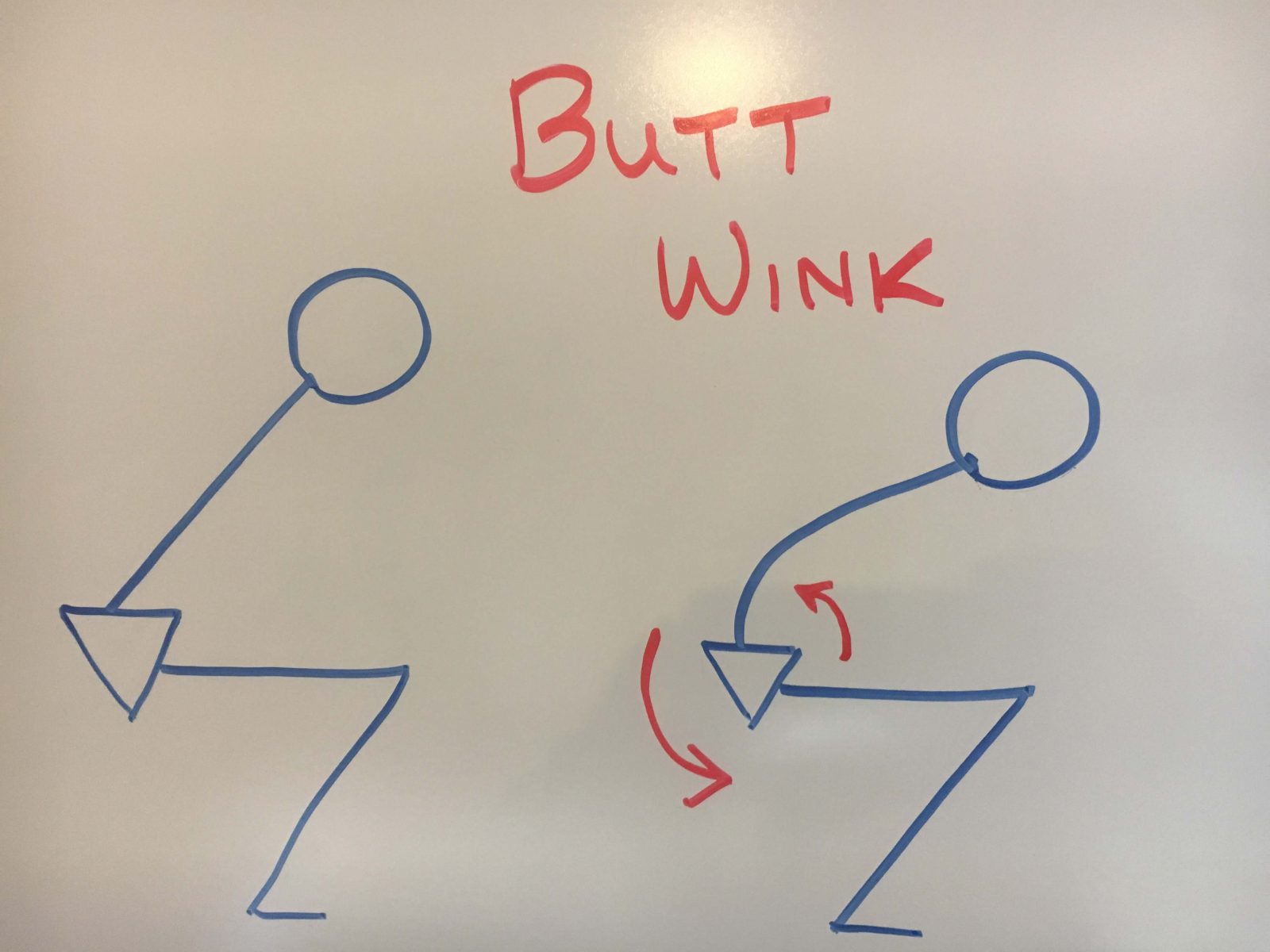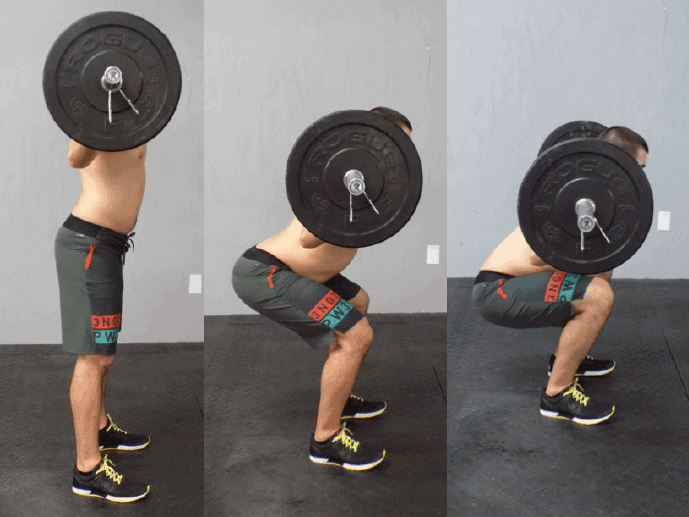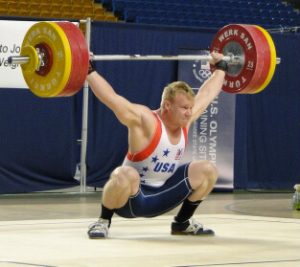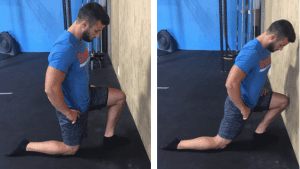The squat butt wink is one of the most well known of all squat movement faults. If you haven’t heard of butt wink before, it is the term used to describe the excessive rounding of the lower back as an athlete drops down into the bottom of the squat. This puts the body in a sub-optimal position for developing and transferring force.
While some research supports the idea that this unnecessarily loads the spine, that is a much more in-depth discussion than we will get into here. But in my opinion, if given the choice between a spine staying “neutral” or flexing, I choose neutral.
Before we dive deeper into the causes and fixes of the squat butt wink, it is important to note that a small amount of lumbar flexion is unavoidable, especially when squatting deep. When I discuss butt wink, I am referring only to when large amounts of flexion occur, taking the lumbar spine to near end-range flexion.
The common prescription when an athlete is noted to butt wink in their squat is more mobility work. But it is important to note that motor control issues also contribute to the butt wink. To correct the butt wink, we must first accurately identify the cause of it rather than taking the “shotgun approach” that so many use by throwing random exercises at the problem and hope that something sticks!
For a video version of this article, watch the below:
Fixing the Squat Butt Wink
Step One: Watch the Squat!
We’ve got to start by simply looking at the squat pattern as a whole. So often, motor control problems can be seen in a simple air squat that will immediately cue you into the root cause.
When we examine someone with a suspected butt wink, we need to determine which issue we are dealing with:
- Someone who starts with a neutral spine and flexes as they descend
- Someone that starts overextended and flexes to neutral during the squat (pic below)
. If it is the second option, the athlete will APPEAR like they are going into a butt wink but they are just moving to a neutral position. Both need to be addressed but will lead us to many different treatments.
For those that start overextended and then flex to a neutral position, we simply have to work their motor control and proprioception to have them start and maintain neutral positioning. To teach that, I usually use a progression of exercises including 90/90 breathing, quadruped rocking, and RNT Overhead squats. These movements teach that individual where neutral spine positioning is and how to lock in core strength during squats. I demonstrate these movements in the video “Fix Your Overhead Squat.” Then as we reintroduce heavy loads to the squat, we’ll work on improving the bracing sequence.
For those that start in a more neutral position but then lose positioning as they descend, we much dig dipper into the cause of their butt wink. For that, we will start by looking into their mobility. If mobility is limited, we’ll address that. If mobility is good, then we are back to looking at other motor control drills.
Step Two: Analyze Mobility
I look at squat mobility needs as a continuum between hip and ankle mobility. To have a good squat, you better have good hip and ankle mobility. Or exceptional in one of those and fair mobility in the other. To have a great full depth, ass to the grass squat, you need great mobility in both.
Thus some people without great hip mobility can have a good squat if their ankles are incredibly mobile, and vice versa.
Ankle Mobility
When testing squat specific mobility, the first place to start is always the ankles. With the athlete in half kneeling, I position their big toe one hand width away from a wall or box. I then see if they can touch their knee to the wall while keeping their toes pointed forward and heel flat on the ground. If they can’t do that, I ask where they feel limited. Thightness in the front of the ankle indicates we are more likely dealing with joint stiffness. Stiffness in the back indicates more Achilles / soleus limitations. This will give me a better idea of what treatment they need.
There is a huge variety of ankle mobility movements you can find online, but I suggest looking at our Ankle Mobility Overhaul program. Hundreds of athletes have improved their ankle mobility and squat technique using this program!
Hip Mobility
Next, I move on to the hips. With the athlete on his or her back, I see if they can bring their quads in contact with the abdomen. If so, they have sufficient hip flexion to squat to depth without having a squat butt wink.
Then I’ll assess hip internal (foot moving out as shown below), and external rotation (foot moving inward) with the hip flexed to ninety degrees and the knee directly above the hip joint. I like to see 30 degrees of hip internal rotation and 45 degrees of external. We will find large variations in this hip rotation range. Some individuals have boney blocks towards rotational movement. That is okay. We use these tests to identify which direction might need a bit more focus but don’t hold all hips to those specific ranges.
Again, much has been written about hip mobility, but I highly suggest reading this article I wrote.
For more help improving your mobility, access our FREE mobility checklist!
Squat Positioning
The final test I run when working on the squat butt wink is the hip scour test. In this test, I cautiously move their hip around to assess the optimal position for their hips during squatting. While most people naturally squat here, many have adopted stances outside of what their anatomy dictates is best due to poor coaching and lack of knowledge.
Step Three: More Motor Control Work
If mobility has been cleared, then we need to move on to motor control drills where the athlete re-learns how to move without going into the squat butt wink fault.
The easiest starting point is quadruped rocking, where the athlete can learn to maintain a neutral spine in a gravity-reduced position.
From there, I like to move to goblet squats as holding a weight in front of the body shifts the center of gravity forward and allows for more instinctive neutral spine positioning. I often combine this with eccentric isometrics, which help the athlete feel and own their positioning during the squat. To perform eccentric isometrics, I typically start with a seven-count negative and a five-count pause before quickly standing up.
The “Sit to Squat Drill” is fantastic for athletes losing control of positioning at the bottom of their squat, resulting in squat butt wink.
Place a stool, box, ball, etc. at the approximate level that the athlete loses positioning. Have the athlete sit on the object. The athlete then moves into proper positioning (neutral spine, knees over toes, core engaged, etc.). While maintaining tension throughout the body to maintain alignment, the athlete slightly lifts their buttocks off the object and holds this position for a few seconds before sitting and repeating.
Squat Butt Wink Fix Step Four: Let the Tissues Rest!
The above exercise will go a long way towards fixing the squat butt wink during squats. But what if the athlete also has accompanying hip PAIN? First, I suggest reading “Fixing Hip Pain During Squats”. That will outline a great progression to address the biomechanical factors of hip pain.
Next, the athlete needs to strongly consider taking a break from aggravating exercises and using alternatives to continue building strength as the irritated tissues calm down.
Some potential alternative strength exercises include Split squats, Sled Push and pull, and heavy step-ups.
This rest will be only as long as needed to heal the aggravated tissues and rarely does actual strength decline if good programming is in place utilizing alternative exercises.

